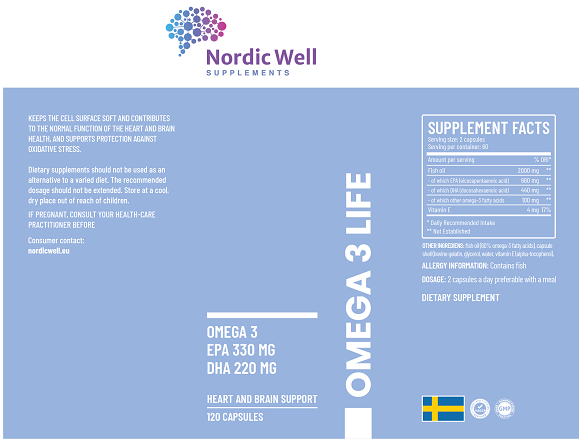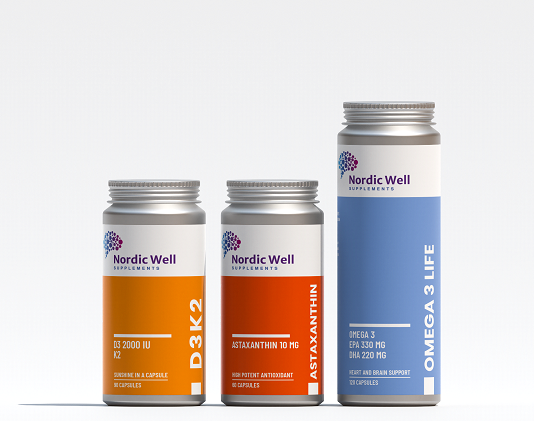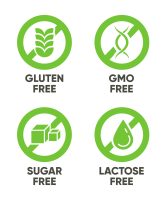
Positive effects of Omega-3:
⦁ Reduces inflammation and allergic reactions (EPA)
⦁ Reduces stress hormones (EPA)
⦁ Counteracts metabolic syndrome and diabetes (EPA)
⦁ Promotes fat burning (EPA)
⦁ DHA has shown a positive effect on children with reading and writing difficulties, concentration difficulties, dyslexia, hyperactivity, ADHD

The recommended dose should not be exceeded. Dietary supplements should not be used as an alternative to a varied diet. Keep out of the reach of small children. Use it with care and speak with a doctor before taking it.

The recommended dose should not be exceeded. Dietary supplements should not be used as an alternative to a varied diet. Keep out of the reach of small children.
They are primarily found in fatty fish such as salmon, herring, anchovies, sardines and mackerel.
Omega 3 are polyunsaturated fatty acids found in fish and plants. The body depends on these fatty acids for important body functions.
The body depends on getting the omega 3 fatty acids from the food we eat. From plants we can only get the short omega 3 fatty acid alpha-linolenic acid (ALA) and from marine animals we can get the long omega 3 fatty acids docosahexaenoic acid (DHA) and eicosapentaenoic acid (EPA). It is these long fatty acid chains that the body can benefit from.
ALA is an essential omega 3 fatty acid as the body cannot produce it itself. But we also call DHA and EPA essential fatty acids because they cannot be converted from other types of fat, but must be supplied to the body via food or converted from the essential fatty acid ALA.
Research has shown that the essential fatty acids are good for the body. The long omega 3 fatty acids EPA and DHA are built into the cell surface, where they can be converted into signaling substances (eicosanoids) in the body.
Highly unsaturated fat in the form of the omega 3 fatty acids DHA and EPA keeps the cell surface soft and contributes to the normal function of the heart*. The fatty acid DHA, in turn, contributes to maintaining normal brain function and normal eyesight*.
Omega 3 from the plant kingdom comes in the form of the short ALA fatty acid and must be converted to the long EPA fatty acids and further to DHA before the body can make use of it.
Fish and marine animals that feed on EPA- and DHA-rich algae get a high content of these fatty acids. Small sea animals are eaten by larger sea animals, and in this way the long omega 3 fatty acids are concentrated in the sea animals. People who then eat these sea creatures get an increased amount of the healthy unsaturated fatty acids in the body.
Humans probably do not convert ALA to EPA efficiently. Therefore, we have to eat much more vegetable oils than fish oils to achieve the same level of the omega 3 fatty acids EPA and DHA in the body.
Omega-3 consists of polyunsaturated fatty acids that have vital functions in the body. Omega-3 contains the fatty acids EPA (eicosapentaenoic acid) and DHA (docosahexaenoic acid) which, among other things, contribute to the normal functioning of the heart, brain and eyes.
Omega 3 in the diet often comes from rapeseed oil-based cooking fat, for example liquid margarine (contains short fatty acids, ALA) and from fish (contains long fatty acids, EPA and DHA). Some nuts, such as walnuts, also provide some omega 3. Olive oil, corn and sunflower oil contain small amounts of omega 3 fatty acids.
The balance between the different fatty acids is important. The body does not only need to get unsaturated fatty acids. To get an optimal effect, they must be taken in a balanced amount.
In today’s diet, it is common for us to get too much omega 6 fatty acids from margarine and vegetable oils compared to omega 3 fatty acids from fish and seafood.
Omega 3 and omega 6 fatty acids give rise to different signaling substances, often with the opposite effect. Therefore, an imbalance between these fatty acids can lead to poorer health. The difference between omega 3 and omega 6 is that omega 3 has a double bond three links from the end of the fatty acid chain, while omega 6 has a double bond six links from the end.
⦁ Good for the heart
The omega-3 fatty acids EPA and DHA contribute to maintaining the normal function of the heart. A positive health effect is achieved with a daily intake of 250 mg of EPA and DHA.
⦁ Good for the brain
The omega-3 fatty acid DHA contributes to maintaining the normal function of the brain. A positive health effect is achieved with a daily intake of 250 mg of DHA.
⦁ Good for eyesight
The omega-3 fatty acid DHA contributes to maintaining the normal function of vision. A positive health effect is achieved with a daily intake of 250 mg of DHA.



